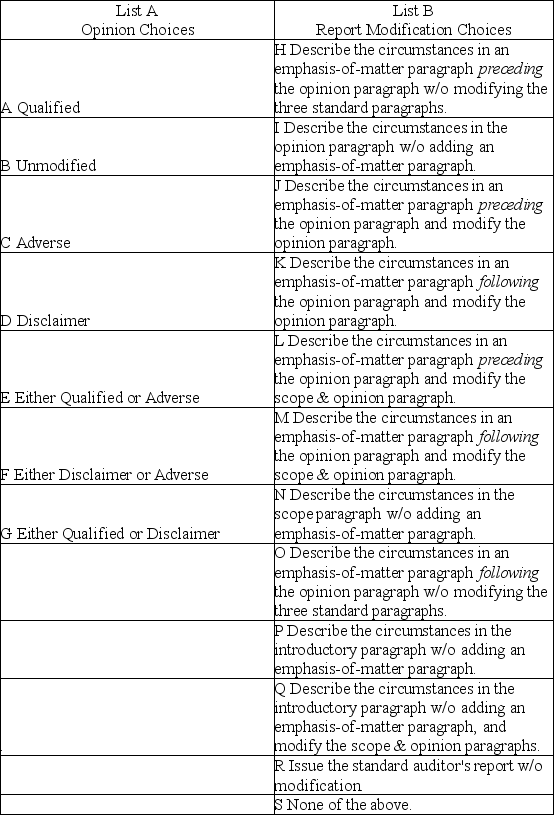Audit situations 1 through 10 present various independent factual situations an auditor might encounter in conducting an audit. List A represents the types of opinions the auditor ordinarily would issue, and List B represents the report modifications (if any) that would be necessary. For each situation, select one response from List A and one from List B. Select, as the best answer for each item, the action the auditor normally would take. Items from either list may be selected once, more than once, or not at all.
Assume the following:
• The auditor is independent
• The auditor previously expressed an unmodified opinion on the prior-year financial statements unless otherwise noted
• Only single-year (not comparative) statements are presented for the current year (unless otherwise stated)
• The conditions for an unmodified opinion exist unless contradicted in the factual scenario
• The conditions stated in the factual scenario are material
• No report modifications are to be made except in response to the factual scenario
Factual Scenario
1. The financial statements present fairly, in all material respects, the financial position, results of operations, and cash flows in conformity with GAAP.
2. In auditing the Long-Term Investments account, an auditor is unable to obtain audited financial statements for an investee located in a foreign country. The auditor concludes that sufficient competent evidential matter regarding this investment cannot be obtained but it is not pervasive to the financials as a whole.
3. Due to recurring operating losses and working capital deficiencies the auditor has substantial doubt about an entity's ability to continue as a going concern for a reasonable period of time. However, the financial statement disclosures are adequate.
4. The principal auditor decides to refer to the work of another auditor, who audited a wholly owned subsidiary of the entity and issued an unqualified opinion.
5. An entity issues financial statements that present financial position and results of operations but omits the related statement of cash flows. Management discloses in the notes to the financial statements that it does not believe the statement of cash flows to be useful.
6. An entity changes its depreciation method for production equipment from straight-line to units of production based on hours of utilization. The auditor concurs with the change, although it has a material effect on the comparability of the entity's financial statements.
7. An entity is a defendant in a lawsuit alleging infringement of certain patent rights. However, management cannot reasonably estimate the ultimate outcome of the litigation. The auditor believes that there is a reasonable possibility of a significant material loss, but the lawsuit is adequately disclosed in the notes to the financial statements.
8. An entity discloses certain lease obligations in the notes to the financial statements. The auditor believes that the failure to capitalize these leases is a departure from GAAP.
9. The entity wishes to show comparative financial statements and include the prior year. However, the prior year financial statements contained a qualification due to an inappropriate method of GAAP. Accordingly, management corrected the prior year GAAP deficiency and included the updated numbers in the comparative financials for the current year.
10. The entity wishes to show comparative financial statements and include the prior year. However, the prior year financial statements were audited by another auditor who refuses to reissue his opinion.

Correct Answer:
Verified
2. A, L
3. B...
View Answer
Unlock this answer now
Get Access to more Verified Answers free of charge
Q150: In most audits, the auditor issues a(n)
A)
Q151: When an adverse opinion is issued, a
Q152: In auditing the long-term investments account, Arens,
Q153: When accounting principles are not consistently applied,
Q154: The following is a portion of an
Q156: For the report containing a disclaimer for
Q157: When a qualified opinion is issued, an
Q158: When a pervasive scope limitation exists,
A) a
Q159: After the balance sheet date but prior
Q160: The following is the introductory paragraph, and
Unlock this Answer For Free Now!
View this answer and more for free by performing one of the following actions

Scan the QR code to install the App and get 2 free unlocks

Unlock quizzes for free by uploading documents